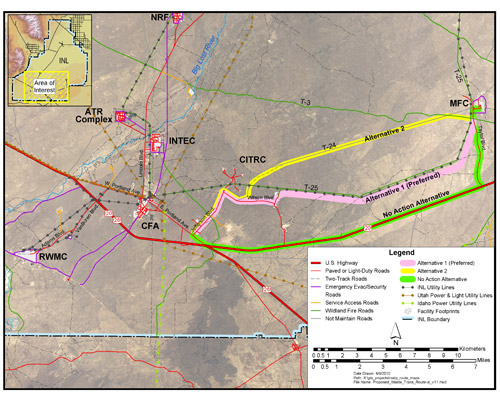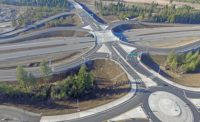In order to move radioactive material to and from three separate facilities at the Idaho National Laboratory, the U.S. Dept. of Energy plans to build 10 miles of new road that will allow it to transport the waste without having to access U.S. Route 20.
U.S. 20 is the longest road in the United States and runs through the southern portion of the INL.
DOE officials say the new road will lie within the nearly 900-sq-mile federal nuclear research center in the Arco Desert between Arco and Idaho Falls, Idaho. The $6.2-million project will be built with American Recovery & Reinvestment Act money and is approximately 100 ft south of an existing power-line maintenance road.
The federal research facility, which was established in 1949 as the National Reactor Testing Station, currently employs more than 4,000 people and has a significant economic impact on Idaho Falls and the surrounding communities. The haul road has a completion date of August 2011.
Mike Coffman, senior project manager for Doyon Project Services of Federal Way, Wash., says his firm will have 24 workers onsite at the peak of the project. “We going to do most of the work with local craft labor,” Coffman says.
Tim Jackson, spokesperson for the DOE’s Idaho Operations Office, says the new road will provide an alternative route for the transport of several thousand shipments of materials and waste expected over the next 10 years and beyond.
“The road will reduce shipment costs, improve operational efficiency and highway safety and reduce impacts to the public by minimizing road closures,” Jackson says. “Currently, shipments are sent via U.S. 20 with access restriction to the highway during shipping periods.”
Jackson adds that total cost savings over a 40-year period are anticipated to be approximately $50 million.
An internal road would allow shipments between INL facilities without affecting public access to the highway. “Presently, shipment schedules are designed to minimize inconvenience to the public, often occurring in the middle of the night, which is not always supportive of INL’s need,” Jackson says.
“The cost and time required for notifications, road closures and shipping container certification is considerable when using the public highway. Improved operations and the ability to do same-day transport between facilities will increase productivity,” he adds.
It’s anticipated that approximately 10,000 to 18,000 shipments will be made over the next 40 years. Currently, materials are transported over U.S. 20, either in full compliance with U.S. Dept. of Transportation regulations or as “out-of-commerce” shipments when full compliance with DOT regulations cannot be achieved.
“Out-of-commerce transportation is shipping on (across or along) a government-controlled road where access by the general public is restricted through the use of gates and guards,” Jackson says.
The project will provide a year-round, nonpublic road entirely within the INL site and provide a more efficient way to transport spent nuclear fuel and special nuclear material.
The trucks used to haul the material range from semi-tractor trailers to dump trucks, with some loads weighing up to 80,000 lb.
Jackson says the new road will allow use of specialized INL shipping containers and eliminates the requirement to use Nuclear Regulatory Commission or DOT-approved containers.
Speed on the road will be limited to 35 mph, and it will be used only for heavy-haul purposes. Routine traffic will continue to use U.S. 20.
Crews are trying to avoid historic artifact areas. Jackson says there are flora and fauna concerns as well.
“A plant species survey was completed in June 2009,” he says. “A walking survey was conducted 100 ft from the middle of the road on each side (200 ft total) to accommodate proposed road widening and turnouts.
“Sage grouse are the main wildlife concern, so we are going to limit our clearing and grubbing around the grouses’ nesting and habitat needs. We’ll complete phase one, and then we’ll shut down on Dec. 1 and continue on May 1 after the grouses’ mating season.”




Post a comment to this article
Report Abusive Comment